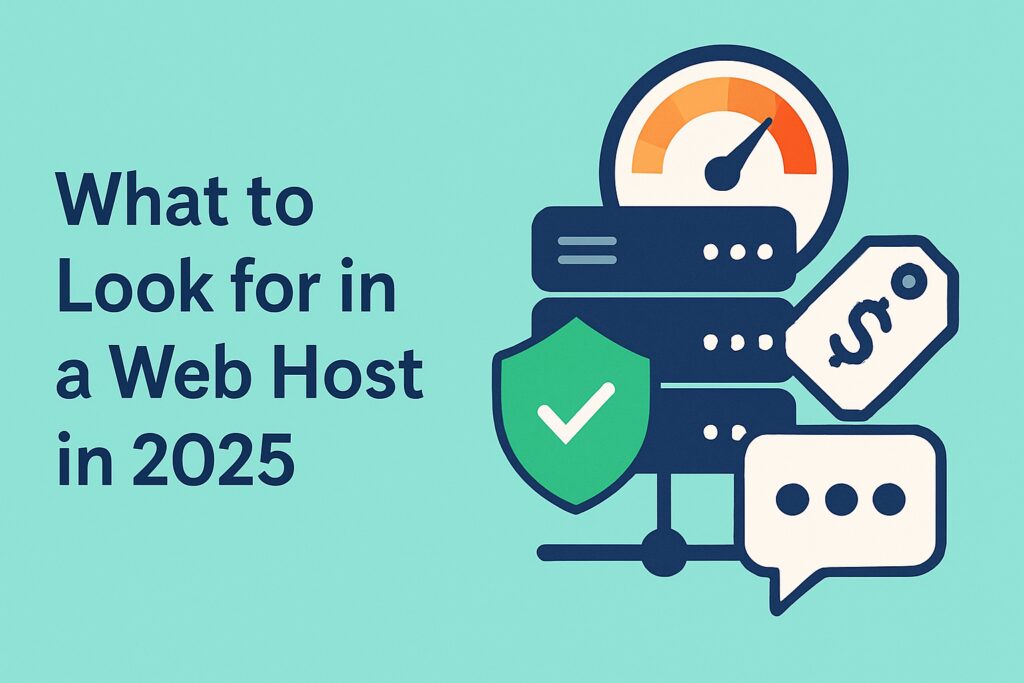Choosing a web host used to be simple.
Find something cheap, click “Buy Now,” and you’re done. But in 2025?
Things are a little more complicated.
The hosting market has exploded — more options, more features, more fine print.
And honestly, a lot of the advice floating around feels… outdated.
Whether you’re launching a blog, running an online store, or managing client sites, your host is the foundation.
If it’s slow, unreliable, or missing key features, your entire site suffers.
Here’s what you actually want to look for in a web host in 2025 — with no fluff.
1. Speed That’s Real — Not Just Promised
Every host claims they’re fast.
But “fast” on a landing page doesn’t always mean fast in practice.
What to check:
-
Server location options (closer = faster)
-
Built-in caching and CDN availability
-
Support for the latest PHP version
-
Use of LiteSpeed, Nginx, or other performance-optimized tech
And don’t just take their word for it — read independent speed benchmarks and real user reviews.
2. Uptime You Can Rely On
Even 99.9% uptime sounds good — until you realize that’s still 40+ minutes of downtime a month.
If you’re running anything mission-critical (like an e-commerce site or lead gen funnel), downtime equals lost money.
Look for:
-
A SLA (Service Level Agreement) that actually guarantees uptime
-
Real-time status pages or uptime reporting
-
A reputation for quick recovery when things do go wrong
3. Managed vs Unmanaged: Know What You’re Signing Up For
In 2025, hosting comes in two main flavors:
-
Managed = the host handles updates, security, and sometimes backups
-
Unmanaged = you get more control, but you’re on your own if something breaks
If you’re not a developer (or don’t want to be one at 2 a.m. on a Sunday), go managed.
Yes, it costs more. But peace of mind is part of the package.
4. WordPress-Specific Perks (If You Use WordPress)
Not all hosts love WordPress equally.
Great WP-focused hosts often include:
-
1-click staging environments
-
Automatic plugin + core updates
-
Server-level caching tuned for WordPress
-
Free migrations from your current host
-
Built-in security layers (like bot protection)
These little conveniences add up fast.
5. Real, Responsive Support
In theory, 24/7 support is great.
In practice, 24/7 bots and “we’ll get back to you” tickets are… not.
Look for hosts that offer:
-
Live chat with real humans
-
Consistent response time under 5 minutes
-
Deep WordPress expertise (not just generic server talk)
Pro tip: Before signing up, message their support with a simple question. How they respond will tell you everything.
6. Transparent Pricing (Watch for Traps)
That $2.95/month plan? It’s probably $12/month when you renew.
Some hosts bake in shady upcharges — for backups, SSL, even email.
Look closely at:
-
Renewal pricing
-
Whether SSL certificates are free
-
Cost of domain renewal if bundled
-
Add-ons they try to slip in at checkout
In 2025, transparency is a feature.
7. Built-In Security Features
Security plugins help — but if your host is lax, you’re still vulnerable.
Look for these server-level protections:
-
Daily malware scanning
-
Firewall + brute force protection
-
Automatic backups (daily or hourly is best)
-
Two-factor authentication for account access
A host that takes security seriously is one you can trust.
8. Flexibility to Grow (Or Scale Down)
Right now, maybe you’re launching a simple site. But what if:
-
You go viral
-
You start selling digital products
-
You add more clients
Your host should be able to scale with you, without a full migration.
Things to ask:
-
How easy is it to upgrade/downgrade plans?
-
Can I host multiple sites later?
-
Are there hard traffic or resource limits?
Final Thoughts
A lot of hosting advice online feels stuck in the early 2010s — all about “who’s the cheapest” or “what’s popular.”
But in 2025, good hosting is about performance, transparency, support, and having the right tools in place before you need them.
Don’t just pick a plan based on price.
Pick a platform that gives your site room to breathe, grow, and stay online when it matters most.
It’s not about overpaying — it’s about not under-investing in the one thing your entire site depends on.

